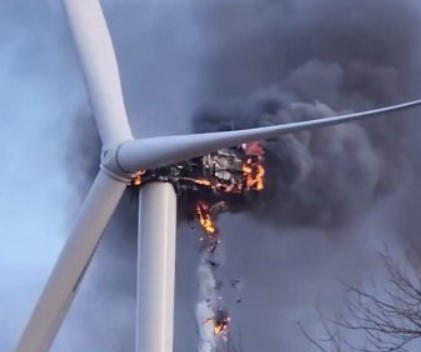Fireaway is a fire supression company who specialize in wind turbines
Next public meeting in West Union NY this Thursday May 18 at 6pm
By Andrew Harris
The “Rexville Fire,” which totally destroyed a wind turbine on the Allegany-Steuben county line in late March, continues to be an evolving and interesting story. That fire not only destroyed the wind turbine, but according to residents nearby, the fire created a mass dispersal of fiberglass material into farms and forests. Some local sources claim to have contamination well over one mile from the fire.
Last month we reported from a public meeting in the town of West Union, a very small community in Steuben County, on the Pennsylvania border but in New York. You can read that full report below but take note of the final question asked by residents and response by the wind turbine firm, NextEra:
Q: Next time this happens, can’t a fire crew address the fire from above to suppress the fire instead of letting it burn out ?
NextEra: We are not aware of any such option or how it would be provided.
At the time it seemed slightly incredulous to think how a fire that was raging at the top of a 400 foot tower could be stopped short of bringing in helicopters. After talking to Lance Harry, CEO of Fireaway Inc, it appears that impression was wrong. His firm specializes in products that are built and incorporated into wind turbines for fire suppression.
The CEO gives all the information on his company and product that a curious mind could want. Here is a short video that gives a good overview of the product:
The Stat-x systems that Fireaway Inc produce are almost always factory installed, very rarely retro-fitted to existing wind turbines. The product and service that Fireaway Inc makes specifically for the wind turbine industry is detailed in the link below, and summarized with that statement from the company website:
“Approximately 90% of wind turbine fires result in significant damage to or a total loss of the wind turbine, as well as significant downtime and thus other economic losses.[6] This is because the typical response is simply to wait for the fire to burn out. Further, burning materials that fall to the ground or are blown by the wind can create a significant risk of extending the fire—and thus damage and loss—to the ground and/or surrounding property.”
Before this reporting goes any further: Obviously Fireaway sees an economic advantage to promoting their products in this situation. We are not advocating or promoting the Stat-X product, but all parties must admit that in hindsight, the technology may have prevented the aftermath of the “Rexville Fire.”
The damage that landowners and NextEra are now in the middle of repairing, reclaimating, mitigating, whatever you want to call it; was caused by the extended time the fire burned. For hours, first responders and NextEra established a perimeter around the burning turbine to keep everyone safe. At the time of the fire, the main concern was to keep the falling debris from harming anyone or causing a ground fire.
The fire burned for hours, and now we know that fiberglass was being distributed across a wide area while it burned.
If the Stat-X system that is described above was integrated into the wind turbine in question, would the disaster have been limited to a destroyed turbine? Would the event have been limited to a spectacle and not elevated to a community crisis?
The electric energy era is already here. NextEra and other wind energy companies are planning for growth in upstate NY. Since the “Rexville Fire,” other local governments are taking notes and doing research on laws that can regulate wind energy development.
Local town boards like in West Union can only make so many demands, can only make good faith agreements, or make basic restrictions on land use. For example, “setbacks,” or how far away a wind tower must be from a residence or farm or water source. In West Union, board member Larry McCaffery says that they successfully negotiated with NextEra for larger “setbacks,” or more distance between the wind towers and homes.
New York State has almost total control of all commercial level wind (or solar) installations, anything over 25 mega watts of power. For the most part, that is everything but a backyard solar project or small farm wind mill.
Based on the legal and regulatory structure in New York State today, the issue of fire suppression systems is state regulated. After consulting with the New York State Department of State, local governments can only demand fire supression systems within local building codes. These massive, 400 foot, free standing wind turbines are not regulated by uniform building codes. We specifically asked the Department of State and they replied:
“Generally, wind turbines which are free standing and not part of a building are not regulated by the Uniform Fire Prevention and Building Code (Uniform Code). A municipality should consult with their local municipal attorney regarding whether they have the ability to adopt a local law to require a fire suppression system, including but not limited to compliance with any other applicable federal, state, or local laws and regulations.
If such wind turbine is part of a building (i.e. on the roof or connected to a building) and regulated by the Uniform Code, the municipality should consult with their local municipal attorney regarding whether they have the ability to adopt a local law to require a fire suppression system and whether they must petition the New York State Fire Prevention and Building Code Council (Code Council) to adopt a more restrictive local standard for construction than the Uniform Code pursuant to Executive Law §379.”
The matter of installing fire supression systems that could have prevented the fall out from the “Rexville Fire,” falls to NYS, or Article 10, or the Office of Renewable Energy Siting.
All wind or solar energy projects that are more than 25 megawatts are automatically taken out of local jurisdiction and into the hands of Article 10. At this point, according to a leading Western New York lawyer who specializes in the subject, every project is different. Gary Abraham, who practices from Cattaraugus County explained that municipalities would have to make the case to the Article 10 siting commission that fire supression was necessary.
That request would be a tall order, especially for a small government like West Union. Wind companies would more than likely resist the demand based on the additional cost. As Abraham explained, to push for an entire wind project to have factory installed fire supression systems would almost certainly require legal action. As of this reporting, no such request or petition or legal action has been taken in New York which would require fire supression systems. In other words, this is unchartered territory in New York State.
The “Rexville Fire,” may become the case study which changes that. We haven’t learned the extent of the damages to the local community, business, and environment yet. But we do know that landowners who have been impacted by the fire, and “fiberglass fallout,” have retained a law firm, Hancock Estabrook, LLP based in Syracuse NY.
How fire supression systems fit into the future of wind farming is still unknown. According to the Fireaway Inc CEO Lance Harry, his products are sold internationally and gaining a reputation as a key risk management tool.
Will NextEra and other wind turbine giants decide to make fire supression systems standard features? That could will depend on how expensive the “Rexville Fire,” aftermath becomes.
This Thursday the West Union town board reconvenes for another regular monthly meeting which will be anything but regular. Local landowner, Tony Lojacono, who attended the last meeting, reported to the Sun today that the town will be bringing in representatives from the NYS Department of Agriculture and Markets and the NYS Department of Health.
The meeting Thursday is at 6 p.m. at the West Union Town hall on Route 248.
Read below our reporting from last month’s very interesting meeting in the town of 500.








